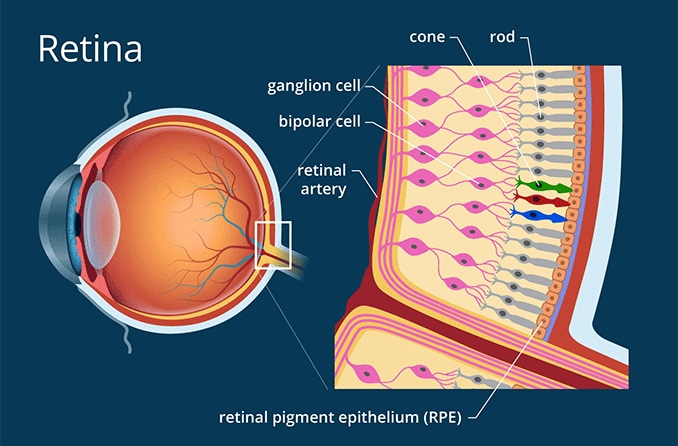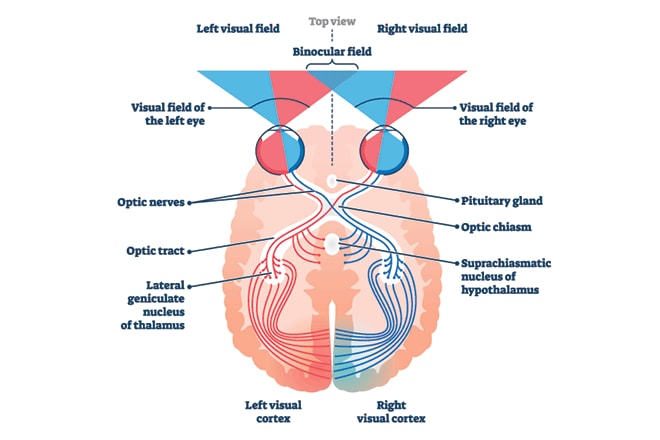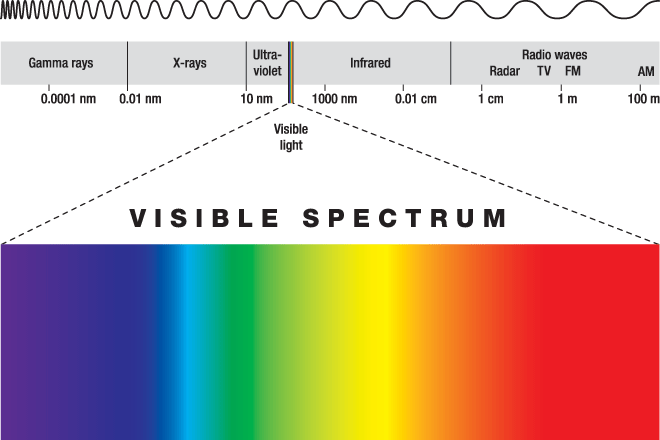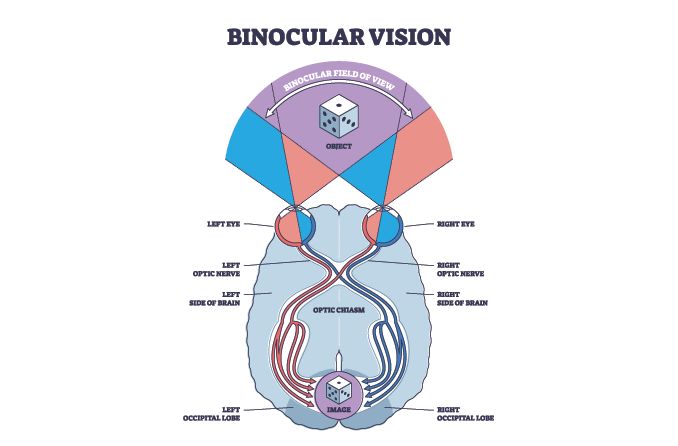How do we see colors in our vision?
Different kinds of light are always interacting with your eyes. You see color when light reflects off an object, enters your eyes, then gets processed by your brain. But these steps aren't as simple as they seem.
The color-sensing cells inside your eyes
You have a thin layer of cells in the back of each eye called a retina. This includes millions of photoreceptor cells that react to different kinds of light.
There are two types of photoreceptors: rods and cones.
- Rods help you see in low light and around your central field of view (your peripheral vision). They don't help you see in color, only in black and white.
- Cones are the part of the eye that lets you see colors. They also help you make out fine details and see in bright light.

You have millions of color-sensitive cone cells in the back of each eye.
The average human has about six million color-receiving cones in their eyes. That might sound like a lot, but not compared to your rod cells. You have more than 100 million of those.
Someone with normal color vision has three types of cones. Each one responds to a different color:
- Red
- Blue
- Green
When colored light enters your eye, it "activates" the color receptors that go with that color.
Colors like yellow, purple and brown are a blend of these colors, so they activate two or even all three types of cones at once. When all three cones react equally, you see the color white. Researchers have also found that some cones only respond to white.
Take this daytime flower scene as an example.
The vibrant petals absorb most of the sunlight but reflect the red light away. Some of this reflected light travels into your eye and activates the red cones in your retina.
Elsewhere in the scene:

The flower and background in this scene activate all three types of cones at the same time.
- Light from the leaves and trees is activating your green cones.
- Light from the sky is activating your blue cones.
- Light from the pollen in the center of the flower is activating your red and green cones at the same time. That makes it look yellow.
In an instant, these color signals leave your eye through the optic nerve and make their way toward your brain.
You can't see colors without the brain
Your eyes are just the first step to seeing colors. Your cones send the message, but it won't mean much unless your brain processes it.

Nerve signals from your eyes travel along the optic nerve toward the visual cortex in your brain.
The color signals travel from your eyes through your optic nerve and arrive at the visual cortex in the back of your brain.
The visual cortex sends this color information to other parts of your brain so you can process what you're seeing and decide how to react to it.
This is how your brain decodes millions of color signals and lets you see in color. The entire process happens in as little as 13 milliseconds (1/80th of a second). That's around 16 times quicker than the blink of an eye.
Look at the flower image again. When you see its red shape, different parts of your brain work together to help you recognize it as a flower. It might even make you feel happy or captivated. That's your brain at work, too.
READ MORE: Is vision our most important sense?
How many colors can humans see?
Many researchers think humans with normal color vision can see between one and 10 million different colors. This can vary depending on the person.

Humans can see up to 10 million colors, but those make up a very small slice of the electromagnetic spectrum.
These colors make up the visible light spectrum. It's the tiny slice of the electromagnetic spectrum we can see with our eyes.
Other types of radiation, like radio waves, X-rays and ultraviolet (UV) rays, are on the electromagnetic spectrum too. But humans can't see them because they're outside our visible rainbow.
You may also have heard of "impossible colors" or "imaginary colors." They aren't really impossible, but we don't see them under normal conditions.
One example of "imaginary" colors is what we may see in negative afterimages.
Are there colors humans can't see?
When people think of a color, they probably picture something that's visible to their eyes. But, in a way, there are "colors" we can't see.
In nature, ultraviolet (UV) light is the best example. That's the radiation that comes from the sun and can hurt your eyes and skin if you aren't careful.
You can't see UV light because it's outside the visible light spectrum. But some birds, reptiles and other animals can likely see it.
When a human and a bird look at the same sunflower, they don't see the same thing. The human sees yellow petals, but the bird may see a combination of yellow and UV "color."
This can be hard for people to imagine because they've never seen anything like it before.
Color blindness
It might seem like someone with color blindness only sees in black and white, but that usually isn't the case. They probably still see colors, just in a different way than someone with normal color vision.
Color blindness usually happens when someone's cone cells don't work well or don’t work at all. Sometimes they're missing the cones completely.
About 1 in 12 men and 1 in 200 women are at least a little color blind. Most have red-green color blindness.
Only 1 in 30,000 people see in black in white (or close to it). This is a condition called achromatopsia.
Tetrachromacy
Someone with tetrachromacy has four types of cones instead of three. They may be able to see colors differently than people with normal color vision, sort of like the birds and reptiles from before.
This "super vision" is caused by a genetic mutation that can only happen in female babies. Researchers think this could be relatively common, but it doesn't automatically mean they can see more colors.
That's because many peoples' brains don't process signals from the fourth cones very well. Someone would technically have tetrachromacy in this case, but their color vision would be closer to normal.
Health problems that can affect your color vision
Most colorblind people are born that way. But it can happen later in life too.
This usually happens due to:
- Eye conditions like glaucoma and macular degeneration
- Diseases that change the way your body converts food into energy
- Diseases that affect your heart or blood vessels
- Injuries and other trauma
- Medication side effects or complications
- Other health problems
Schedule a comprehensive eye exam with an eye doctor any time you notice changes in your color vision.
READ MORE: Does it matter if I see an optometrist or ophthalmologist?









